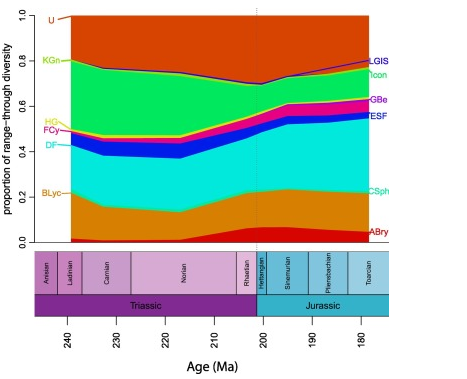
Proportions of range-through diversities of higher taxonomic categories of microfloral elements over the Middle Triassic–Early Jurassic interval (From Barbacka et al., 2017)
Over the last 3 decades, mass extinction events have become the subject of increasingly detailed and multidisciplinary investigations. Most of those events are associated with global warming and proximal killers such as marine anoxia. Volcanogenic-atmospheric kill mechanisms include ocean acidification, toxic metal poisoning, acid rain, increased UV-B radiation, volcanic darkness, cooling and photosynthetic shutdown. The mass extinction at the Triassic-Jurassic Boundary (TJB) has been linked to the eruption of the Central Atlantic Magmatic Province (CAMP), a large igneous province emplaced during the initial rifting of Pangea. Another theory is that a huge impact was the trigger of the extinction event. At least two craters impact were reported by the end of the Triassic. The Manicouagan Impact crater in the Côte-Nord region of Québec, Canada was caused by the impact of a 5km diameter asteroid, and it was suggested that could be part of a multiple impact event which also formed the Rochechouart crater in France, Saint Martin crater in Canada, Obolon crater in Ukraine, and the Red Wing crater in USA (Spray et al., 1998).

Photographs of some Rhaetian–Hettangian spores and pollen from the Danish Basin (From Lindström, 2015)
Most mammal-like reptiles and large amphibians disappeared, as well as early dinosaur groups. In the oceans, this event eliminated conodonts and nearly annihilated corals, ammonites, brachiopods and bivalves. In the Southern Hemisphere, the vegetation turnover consisted in the replacement to Alisporites (corystosperm)-dominated assemblage to a Classopollis (cheirolepidiacean)-dominated one. But there was no mass extinction of European terrestrial plants during the TJB. The majority of genera and a high percentage of species still existed in its later stages, and replacement seems to have been local, explainable as a typical reaction to an environmental disturbance. In Greenland, for example, the replacement of Triassic wide-leaved forms with Jurassic narrow-leaved forms was linked to the reaction of plants to increased wildfire. In Sweden, wildfire in the late Rhaetian and early Hettangian caused large-scale burning of conifer forests and ferns, and the appearance of new swampy vegetation. In Austria and the United Kingdom, conifers and seed ferns were replaced by ferns, club mosses and liverworts. In Hungary, there was a high spike of ferns and conifers at the TJB, followed by a sudden decrease in the number of ferns along with an increasing share of swamp-inhabiting conifers.
Although certain taxa/families indeed became extinct by the end of the Triassic (e.g. Peltaspermales), the floral changes across Europe were rather a consequence of local changes in topography.
References:
Maria Barbacka, Grzegorz Pacyna, Ádam T. Kocsis, Agata Jarzynka, Jadwiga Ziaja, Emese Bodor , Changes in terrestrial floras at the TriassicJurassic Boundary in Europe, Palaeogeography, Palaeoclimatology, Palaeoecology (2017), doi: 10.1016/j.palaeo.2017.05.024
S. Lindström, Palynofloral patterns of terrestrial ecosystem change during the end-Triassic event — a review, Geol. Mag., 1–23 (2015) https://doi.org/10.1017/S0016756815000552
Van de Schootbrugge, B., Quan, T.M., Lindström, S., Püttmann, W., Heunisch, C., Pross, J., Fiebig, J., Petschick, R., Röhling, H.-G., Richoz, S., Rosenthal, Y., Falkowski, P. G., 2009. Floral changes across the Triassic/Jurassic boundary linked to flood basalt volcanism. Nat. Geosci. 2, 589–594. doi: 10.1038/NGEO577.
N.R. Bonis, W.M. Kürschner, Vegetation history, diversity patterns, and climate change across the Triassic/Jurassic boundary, Paleobiology, 8 (2) (2012), pp. 240–264 https://doi.org/10.1666/09071.1